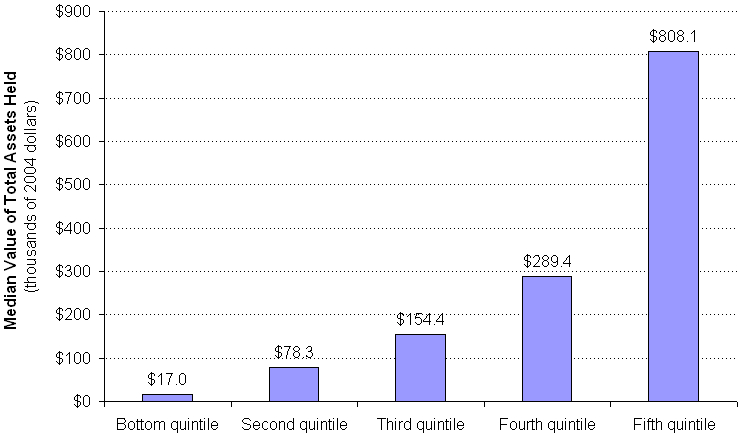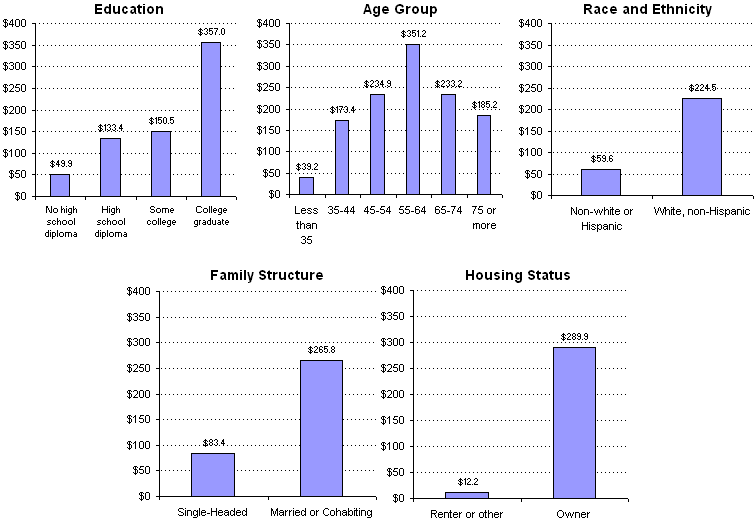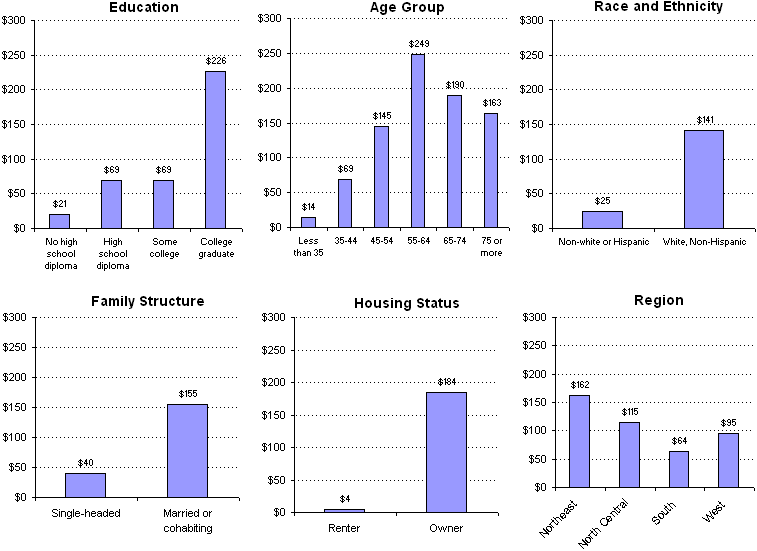Contents
Building assets and avoiding excessive debt can help low-income families insure against unforeseen disruptions, achieve economic independence, and improve socio-economic status. Assets are especially important for low-income families because they can limit the likelihood of material hardships. However, a comprehensive portrait of the balance sheets of low-income households does not exist. There is little available information on crucial questions, such as: What are the asset holdings of low-income households? Do a large proportion of American families save and invest too little to create a healthy balance sheet? This report synthesizes extant research and sets the stage for future research and policy discussion by attempting to answer the following two research questions:
- What are the significant assets of low-income households?
- What are the significant liabilities of low-income households?
Methods and Data Sources
We reviewed 20 studies to synthesize available information on the assets and liabilities of low-income households. Most of the wealth data in this report come from tables produced by Bucks et al. (2006) using the 1992-2004 Survey of Consumer Finances (SCF), Lerman (2005) using the 2001 Survey of Income and Program Participation (SIPP), Caner and Wolff (2004) using the 1984-99 panels of the Panel Study on Income Dynamics (PSID), and Lupton and Smith (1999) using the 1992 Health and Retirement Study (HRS).
These are all high quality surveys, but it is still important to bear in mind some of the data limitations of these surveys, such as imputations for missing asset and liability data, varying survey response rates, and the fact that some assets are difficult to measure and are therefore not included in many surveys. As this report depends in large part on national household surveys for the portraits of assets and liabilities, little can be said about Social Security benefits, defined-benefit pensions, and holdings of durable goods other than vehicles.
[ Go to Contents ]
Portraits of Families
Low-income families
Assets. Based on tabulations of the 2004 SCF, the typical bottom quintile family may own a car (65 percent of families) valued at $4,500 and hold a checking or savings account (76 percent of families) valued at $600. It is those bottom quintile families who own a home (40 percent) valued at $70,000 that raise total median assets for all bottom quintile families to $17,000, one-ninth the assets of third quintile families (exhibit ES-1). Most bottom quintile families do not own a home (60 percent), have no retirement account (90 percent), and have no business equity (96 percent). Social Security and Medicare, if considered wealth, comprise roughly 90 percent of expected wealth for low-income families (Steuerle and Carasso 2004).
ES Exhibit 1.
Median Total Asset Holdings by Income Quintile, 2004

Income Percentile
Source: The Urban Institute. Data from Bucks et al. (2006) using the 2004 Survey of Consumer Finances.
Note: Breakout of income quintiles: Q1: $18,000; Q2: $18,000-$31,999; Q3: $32,000-$51,999; Q4: $52,000-$85,999; Q5: >85,999.
Liabilities. The typical bottom quintile family may hold debt (53 percent) valued at $7,000, one-sixth the amount of debt that most (84 percent) third quintile families hold. Bottom quintile family debt is most likely to be credit card debt (29 percent of families) valued at $1,000, installment loans (27 percent of families) valued at $5,600, and home-secured debt (16 percent of families) valued at $37,000. Debt burdens for bottom quintile families can be high: 27 percent of bottom quintile families made debt service payments that exceeded 40 percent of family income. The combination of assets and liabilities for bottom quintile families results in median net worth valued at $7,500, nearly one-tenth the net worth of third quintile families.
Low-education families
Assets. The typical family headed by someone without a high school diploma may own a home (56 percent) valued at $75,000, a car (70 percent) worth $7,400, and hold a checking or savings account (72 percent) worth $1,100. In total, a typical less-educated family may own assets worth $49,900 (exhibit ES-2), or a little less than a seventh of the assets owned by the typical family headed by a college graduate. Most families headed by someone without a high school diploma do not own any retirement accounts (84 percent) or any business equity (96 percent).
ES Exhibit 2.
Median Total Asset Holdings by Family Characteristic, 2004
(in thousands of 2004 dollars)

Source: The Urban Institute. Data from Bucks et al. (2006) and Urban Institute tabulations using the 2004 Survey of Consumer Finances.
Liabilities. The typical family headed by someone without a high school diploma may hold debt (53 percent) valued at $12,000, or about one-ninth the debt of a family headed by a college graduate. The reason for the disparity is that while 56 percent of families headed by someone without a high school diploma own a home, only 25 percent owe mortgage debt (valued at $44,000) compared with 61 percent of college graduate families (valued at $125,000). Families headed by someone without a high school diploma are slightly more likely to carry installment debt (28 percent) valued at $7,000 and credit card balances (30 percent) valued at $1,200, than mortgage debt. The combination of assets and liabilities for families headed by a person without a high school diploma result in median net worth valued at $21,000 (exhibit ES-3), just one-tenth the net worth of families headed by a person with a college degree. The net worth gap by education group starts out small at younger ages and then widens sharply with age.
ES Exhibit 3.
Median Net Worth by Family Characteristic, 2004
(in thousands of 2004 dollars)

Source: The Urban Institute. Data from Bucks et al. (2006) and Urban Institute tabulations using the 2004 Survey of Consumer Finances.
Single-headed families
Assets. The typical single-headed family may own a home (55 percent) worth $120,000, a car (77 percent) valued at $7,600, and hold a checking or savings account (88 percent) valued at $2,000. In total, a typical single-headed family may own assets worth $83,400 (exhibit ES-2), or less than one-third of the assets owned by the typical married or cohabiting family. Most single-headed families do not own any retirement accounts (65 percent), financial assets beyond their checking or savings account, or any business equity (94 percent).
Liabilities. The typical single-headed family may hold debt (67 percent) valued at $24,000, a little more than a quarter of the debt that most (82 percent) married or cohabiting families hold. The reason for the disparity is that, very similar to less-educated families, only 32 percent of single-headed families owe mortgage debt (valued at $75,000) compared with 59 percent of married or cohabiting families (valued at $105,000). The typical debts owed by a single-headed family, therefore, are most likely to be credit card debt (41 percent) valued at $1,000 or installment loan debt (37 percent) valued at $8,600. The combination of assets and liabilities for single families results in median net worth valued at $40,000 (exhibit ES-3), or about one-fourth the net worth of married or cohabiting families. The net worth gap by marital status starts out small at younger ages and then widens sharply with age.
Nonwhite or Hispanic families
Assets. The typical family headed by someone who is a nonwhite or Hispanic owns a vehicle (76 percent) worth $9,800 and a checking or savings account (81 percent) worth $1,500, compared to the typical white non-Hispanic headed family who owns a vehicle (90 percent) worth $15,700 and a checking or savings account (96 percent) worth $5,000. This nonwhite or Hispanic headed family may own a home (51 percent) worth $130,000 or a retirement account (33 percent) worth $16,000. A typical nonwhite or Hispanic headed family holds total assets worth $60,000 (exhibit ES-2), or a little more than a quarter of the assets held by a white non-Hispanic headed family ($224,500). While only 49 percent of nonwhite or Hispanic headed families do not own a home, 67 percent have no retirement account and 94 percent have no business equity.
Liabilities. The typical nonwhite or Hispanic headed family holds debt (73 percent) valued at $30,500, less than half of the debt that most (78 percent) white non-Hispanic families hold, or $69,500. The reason the gap is not larger is because enough nonwhite or Hispanic headed families pay mortgages (37 percent) worth $83,000 in comparison with white non-Hispanic families (52 percent) with mortgages worth $98,000. Nonwhite or Hispanic headed family debt is somewhat more likely to be credit card debt (47 percent) valued at $1,600 or installment loan debt (43 percent) valued at $9,600, than mortgage debt. The combination of assets and liabilities for nonwhite or Hispanic headed families results in median net worth valued at $25,000 (exhibit ES-3), less than one-sixth the net worth of white non-Hispanic-headed families.
Renter families
Assets. Based on our findings, the typical renter family may own a car (73 percent) valued at $7,200 and hold a checking or savings account (81 percent) valued at $1,100. Renter families that own a retirement account (26 percent) valued at $11,000 raise total median assets for all renter families to $12,200 (exhibit ES-2). Still, this amount is less than one-twenty-fourth (around 4 percent) of the median assets held by homeowner families. Renter families do not own their homes (by definition), they are unlikely to hold retirement accounts (74 percent) or other financial assets other than a checking or savings account (about 43 percent), and have no business equity (96 percent).
Liabilities. The typical renter family holds debt (63 percent) valued at $7,800, about one-twelfth the debt that most (82 percent) homeowner families hold. This is almost entirely because these families do not own homes and so do not have mortgages. Renter family debt is therefore most likely to be installment loan debt (45 percent) valued at $8,700 or credit card debt (also 40 percent) valued at $1,500. Debt burdens for renter families that carry debt are typically very low: four percent of renter families have debt ratios greater than 40 percent compared with 15 percent of homeowners. However, 19 percent of renters are delinquent on their debts compared with just six percent of homeowners. The combination of assets and liabilities for renter families results in median net worth valued at $4,000 (exhibit ES-3), just one-forty-sixth (around 2 percent) of the net worth of homeowner families.
The low net worth family
A descriptive portrait of a low net worth family would be one that is bottom income quintile, headed by a single, Hispanic or nonwhite person under 35 years of age without a high school diploma. Families who do not own a home are much more likely to have low net worth than families who do own a home.
[ Go to Contents ]
Suggestions for Future Research
Paint More Detailed Portraits of Low-Income Families
- Account for age patterns in portraits of low-income families, given the important life course patterns in asset accumulation.
- Create more detailed portraits of families of interest for policy purposes, such as welfare participants and nonparticipants, and family types that do and do not own homes.
- Provide greater detail on the role that bankruptcy may play in the asset accumulation of low-income families.
- Examine family holdings of consumer durables such as furniture, appliances, and equipment, since they may be important time saving and income-generating assets for low-income families.
- Investigate the role that region and rural status play in asset accumulation and the types of assets families accumulate.
- Consider the assets and liabilities of families below the median income. How different is the portrait for families at the 10th, 20th, 30th, and 40th percentiles of the income distribution from those at the median?
- Compute expected levels of assets and liabilities, using asset and liability holding rates and median and mean levels of such assets or liabilities. Expected levels may better illustrate the dual disadvantage faced by many low-income families: not only do they tend to have lower levels of assets and liabilities when they hold them than higher-income families, they are also much less likely to hold these assets and liabilities.
- Examine the role that Social Security, Medicare, and defined-benefit plans play in asset accumulation for low-income families and how best to value these important programs alongside more traditional concepts of assets, such as homes and bank accounts.
Future Research Using Portraits of Low-Income Families
- Assess the benefits of owning homes, pensions, and cars, and the incentives and disincentives low-income families face in trying to acquire them. U.S. families accumulate assets primarily through owning these key assets. The striking lack of homeownership and pension ownership among low-income families, along with the relatively low car ownership rate, go a long way toward explaining the low asset holdings of U.S. low-income families.
- Assess the role that different types of assets and debts play in overall asset-accumulation, upward mobility, and the well-being of low- and moderate-income families. The portraits presented in the report uncover some important differences in outcomes for families that hold secured versus unsecured debt. Future research may reveal that some debts place families in a position to accumulate wealth while other debts effectively limit or drain wealth.
- Future policy research could examine policies that better replicate the wealth outcomes of moderate-income families for low-income families.
More broadly, future research could assess and suggest ways to improve the data sources available to study assets, and analyze the determinants of asset holdings, the benefits of asset holdings, and the role of policy in improving the asset holdings and well-being of low- and lower-middle-income families.
